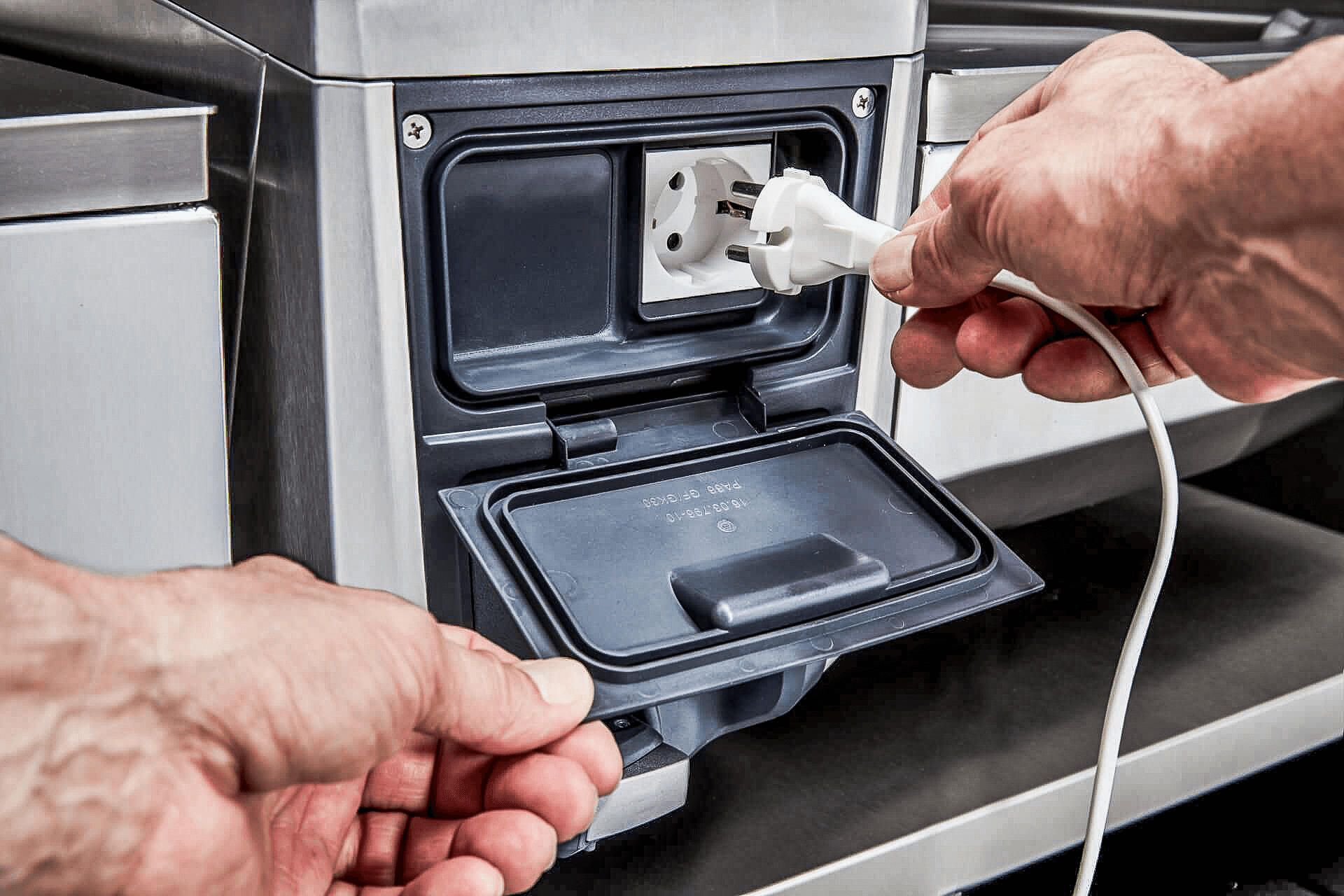“Food is both a major cause and an important solution to global warming,” says Anthony Myint, co-founder of Zero Foodprint, a non-profit organization that works with the hospitality and food industry to combat climate change. Indeed, the issue of sustainability is becoming increasingly important, especially in the gastronomy sector, which is so closely linked to food production and processing. On the one hand, younger target groups in particular are demanding more sustainability in professional kitchen ; on the other hand, gastronomy businesses that do not think ahead are also putting themselves at risk.
The good news, however, is that small changes and adjustments can already cut food waste and packaging waste as well as reduce the CO₂ footprint. But how do you keep track of the many different measures and identify which adjustments can be made? The following checklist contains the most important tips for an environmentally friendly commercial kitchen.
Checklist for a sustainable professional kitchen:
1. No more standby
One of the biggest challenges that restaurant owners face is high energy consumption and the associated costs. On average, a restaurant requires five to seven times as much electricity per square meter as a conventional commercial building. The greatest amount of energy goes into preparing, preserving and storing food. Even when kitchen appliances are in stand-by mode, they still consume energy, which in turn unnecessarily increases electricity consumption and costs. Connecting griddles, coffee machines or ice cream makers to a power strip with an off switch saves both energy as well as time, since the cooking systems do not have to be switched off individually.

Image: iVario Pro | RATIONAL
2. Switch to LED lighting
Although LED lamps are more expensive, they belong in every sustainable professional kitchen since they consume up to 90 percent less energy compared to normal light bulbs and last for around 50,000 hours. What’s more, unlike energy-saving bulbs, LEDs do not contain any environmentally harmful substances such as mercury. This means they do not have to be disposed of as hazardous waste, but can be recycled instead. Motion detectors help to save energy in areas such as cold rooms, storage rooms and bathrooms that do not require lighting for several hours at a time.
3. Power saving during cooling
Minus 18 degrees is the standard for deep-freeze storage. Approximately 4 to 6 percent more electricity is required for each degree below this. Digital monitoring solutions keep you on top of things and give timely warning about any temperature deviations. By having a clear food list, you can also minimize the time spent searching for the food you want and avoid unnecessary warm air getting in. It is also important to clean the cooling systems regularly, especially the condenser fins. This means that heat can continue to be dissipated effectively and power consumption can be kept low. By doing so, you can also avoid potential failures and extend the service life of the cooling system. A full fridge, ideally cleaned weekly, usually consumes less energy than an empty fridge that is dirty and icy.
4. Replace old kitchen appliances with more energy-efficient models
To make the professional kitchen more sustainable, it is worth comparing the energy, operating and maintenance costs of old appliances with those of new ones and calculating the payback period. This applies in particular to baking and convection ovens, steamer, refrigerators and freezers, dishwashers or fully automatic coffee machines. The energy label shows how environmentally friendly the new item actually is. Class A consumes the least amount of electricity, class G the most. Another question you should ask yourself is whether several individual appliances or a multi-functional appliance would be better suited to a sustainable professional kitchen . The iVario from RATIONAL falls into the latter category, for example. The iVario makes it possible to cook, fry and deep-fry with just one appliance, up to 4 times faster and with up to 40 % less energy.

Image: Rational
5. Identify potential savings
Do you want to keep an eye on your kitchen appliances and save energy at the same time by means of digital kitchen management? Digital networking solution such as ConnectedCooking make this possible. It displays the precise energy consumption of the individual cooking systems and thereby helps you maintain an overview and identify potential savings – a benefit Heinz Reitbauer also likes to use in Steireck. Every chef can also control the cooking systems via the app and download all relevant HACCP from any location.

Image: Fotolia
6. Shop regionally, cook seasonally
But sustainability doesn’t just start in the commercial kitchen, it actually begins long before when selecting the ingredients. To ensure maximum sustainability, the focus should be on how food is produced, processed and transported as well as the energy and resources consumed. Regional products (or even better: home-grown) don’t just have the advantage of short delivery routes, they also allow you to source fresh and seasonal produce and boost local suppliers. There are now apps and platforms such as Foodroots, Nearbuy, Regenerative Switzerland or Solify that connect farmers and customers by displaying where regional food is available.

Image: AdobeStock | Eleven studio
7. Proper waste management
Another important point on the checklist for a sustainable professional kitchen is food waste. The United Nations estimates that around a third of the food produced worldwide is thrown away or lost along the value chain. In other words: If food wastage were a country, it would be the third largest emitter of greenhouse gasses – right after China and the USA. Alongside private households and the retail sector, the food service industry is one of the biggest wasters.

Image: AdobeStock | Nikolay N. Antonov
As mentioned previously, however, there are also numerous ways to save food. But before reducing food waste, you need to know where most food waste is generated. The environmental organization WRAP therefore recommends dividing waste into three categories:
- Food waste generated during meal preparation and cooking
- Food that cannot be used because it is (supposedly) spoiled
- Leftovers guests leave behind
To do this, you should collect data for at least one month to determine where there is room for improvement. Apps such as Nospoilers also simplify regular stocktaking and help professional kitchens to keep an overview of stock levels.
8. Cooking without leftovers
Those who follow the leaf-to-root principle (for plants) or the nose-to-tail principle (for animals) try to extract everything from an ingredient instead of simply disposing of the leftovers. For example, carrot, celery or onion leaves can be used to cook stock. Lemon or orange peel (from certified organic cultivation) gives desserts that little extra something. And bread crusts can be processed into bread potato chips, croutons or breadcrumbs for battering.

Image: AdobeStock | Andrea
9. Offer different portion sizes and options
Half-full plates are often sent back to the kitchen with the remark, “It was very good, but too much.” Smaller portion sizes and specific information on the menu, such as “for small appetites” or “perfect for sharing”, can help. By talking to service staff, who receive direct feedback from customers, it is easier to assess which dishes generate the most waste. If you also have several options to choose from – such as sauces, dressings or side dishes – less food is usually left behind. If there are still leftovers, guests should be able to take them home in sustainable packaging. This can be a container brought from home, as well as a reusable container (possibly with a deposit) or a box made from renewable raw materials. Plastic should be a no-go here.
10. Get the team on board
However, you can only put good intentions into practice if everyone is convinced this is the way to go. Anyone who wants to set up their professional kitchen as sustainably as possible needs many helpers. It is therefore best to set goals together with your employees and provide relevant training. This ensures they don’t just know what needs to be done and taken into account, they also know why these measures are important.

Image: AdobeStock | Jacob Lund
This checklist naturally only serves as a starting point and inspiration to give you an overview of the adjustments you can make. No matter what further steps you decide to take, whether it’s investing in a rapid composter or environmentally friendly delivery vehicles, using electricity from renewable energy sources or giving up meat altogether – in the end, many paths lead to greater efficiency and environmental protection in the food service industry.
















